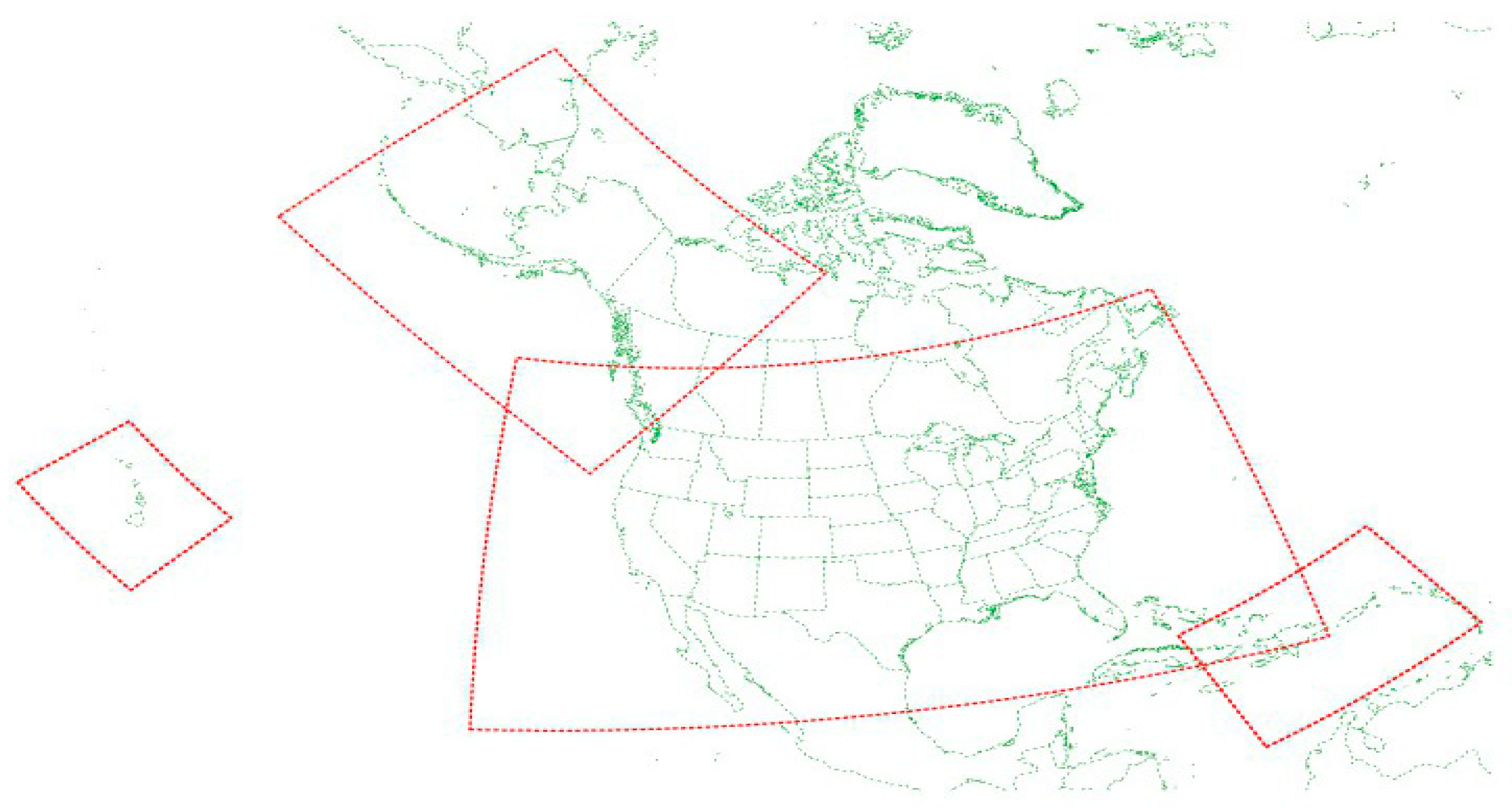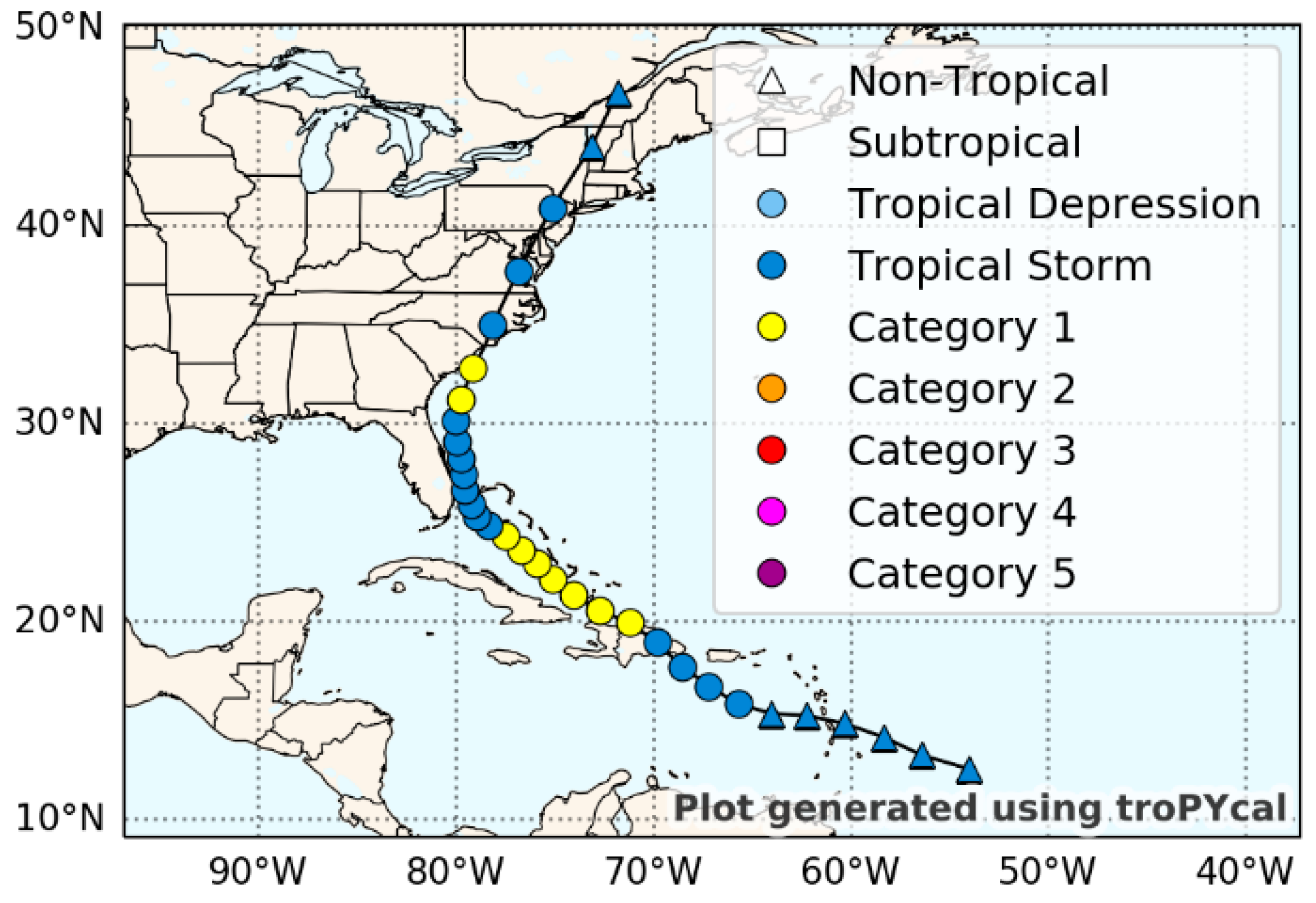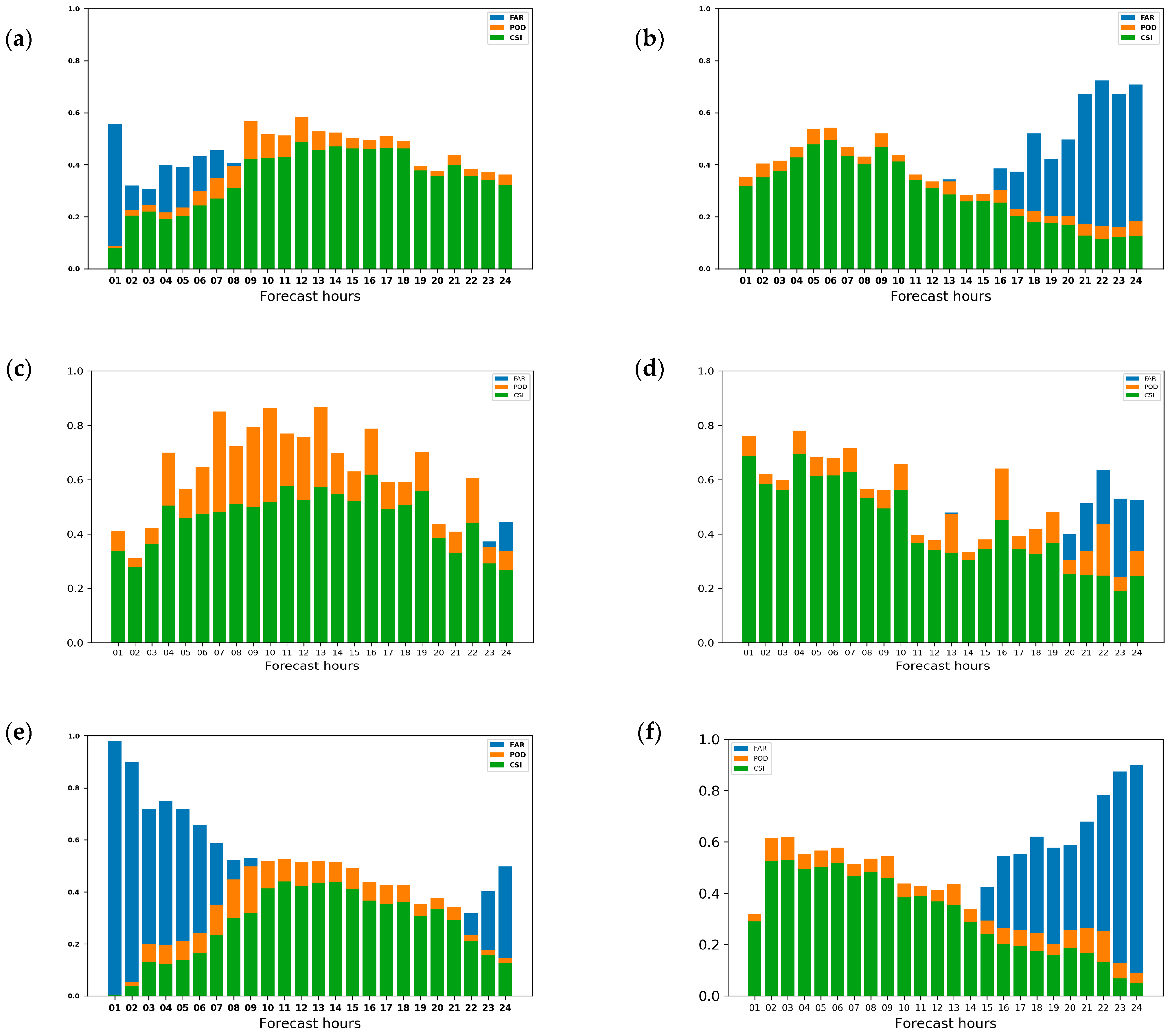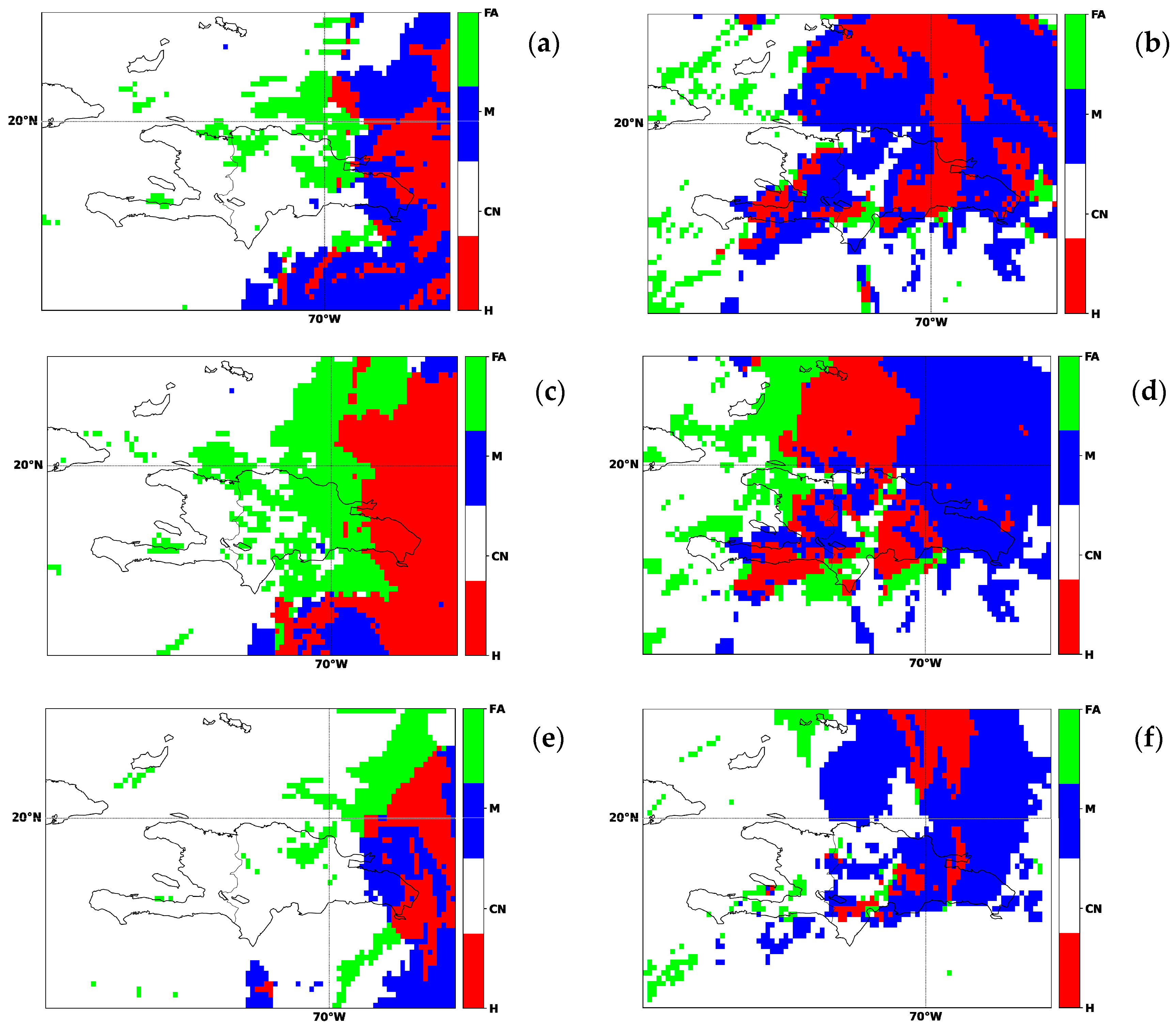Precipitation Forecast Verification of the FFGS and SisPI Tools during the Impact of the Tropical Storm Isaias over the Dominican Republic †
Abstract
:1. Introduction
2. Materials and Methods
2.1. Flash Flood Guidance System
2.2. Nowcasting and Very Short Term Forecast System
2.3. Isaias
2.4. Data Used and Verification Methods
3. Results Discussion
3.1. Comparison between GPM and Surface Stations
3.2. Categorical Verification
4. Conclusions
- In general, the three evaluated forecast systems showed good ability to forecast the rainy areas of Tropical Storm Isaias.
- For the forecast of rain occurrence, the HIRESW-NMMB presents the best results, with a probability of detection that reaches a value of 0.8.
- The HIRESW-ARW and SisPI systems have better performance than the HIRESW-NMMB for heavy rain values.
- SisPI presents the highest FAR index values.
Author Contributions
Data Availability Statement
Acknowledgments
Conflicts of Interest
References
- Hou, A.Y.; Kakar, R.K.; Neeck, S.; Azarbarzin, A.A.; Kummerow, C.D.; Kojima, M.; Oki, R.; Nakamura, K.; Iguchi, T. The Global Precipitation Measurement Mission. Bull. Am. Meteorol. Soc. 2014, 95, 701–722. [Google Scholar] [CrossRef]
- WWRP/WGNE Joint Working Group on Verification. Forecast Verificacion-Issues, Methods and FAQ (pdf Version). 2018. Available online: http://www.cawcr.gov.au/staff/eee/verif/verif_web_page.html (accessed on 15 May 2020).
- Sierra-Lorenzo, M.; Ferrer-Hernández, A.L.; Hernández-Valdés, R.; González-Mayor, Y.; Cruz-Rodríguez, R.C.; Borrajero-Montejo, I.; Rodríguez-Genó, C.F. Sistema Automático de Predicción a Mesoescala de Cuatro Ciclos Diarios; Technical Report; Instituto de Meteorología de Cuba: La Habana, Cuba, 2014. [Google Scholar]
- Sierra-Lorenzo, M.; Borrajero-Montejo, I.; Ferrer-Hernández, A.L.; Hernández-Valdés Morfa-Ávalos, Y.; Morejón-Loyola, Y.; Hinojosa-Fernández, M. Estudios de Sensibilidad del Sispi a Cambios de la pbl, la Cantidad de Niveles Verticales y, las Parametrizaciones de Microfısica y Cúmulos, a muy alta Resolución; Technical Report; Instituto de Meteorología de Cuba: La Habana, Cuba, 2017. [Google Scholar]
- Landsea, C.; Franklin, J.; Beven, J. The Revised Atlantic Hurricane Database; Relatório Técnico, National Hurricane Center: Miami, FL, USA, 2015. [Google Scholar]
- Sierra-Lorenzo, M.; Bezanilla-Morlot, A.; Centella-Artola, A.; León-Marcos, A.; Borrajero-Montejo, I.; Ferrer-Hernández, A.; Salazar-Gaitán, J.; Lau-Melo, A.; Picado-Traña, F.; Pérez-Fernández, J. Assessment of Different WRF Configurations Performance for a Rain Event over Panama. Atmos. Clim. Sci. 2020, 10, 280–297. [Google Scholar] [CrossRef]










| Threshold | HIRESW-ARW 0600/1800 | HIRESW-NMMB 0600/1800 | SisPI 0600/1800 | |||
|---|---|---|---|---|---|---|
| 0.1 | 0.725 | 0.851 | 0.824 | 0.852 | 0.668 | 0.702 |
| 50 | 0.457 | 0.484 | 0.263 | 0.269 | 0.397 | 0.472 |
| 100 | 0.138 | 0.274 | 0.042 | 0.136 | 0.317 | 0.254 |
| 150 | 0.038 | 0.160 | 0.003 | 0.132 | 0.177 | 0.129 |
| 200 | 0.025 | 0.1 | 0.0 | 0.048 | 0.041 | 0.009 |
Publisher’s Note: MDPI stays neutral with regard to jurisdictional claims in published maps and institutional affiliations. |
© 2021 by the authors. Licensee MDPI, Basel, Switzerland. This article is an open access article distributed under the terms and conditions of the Creative Commons Attribution (CC BY) license (https://creativecommons.org/licenses/by/4.0/).
Share and Cite
Lorenzo, M.S.; Medina, J.; Sille, J.; Barrios, A.F.; Águila, S.A. Precipitation Forecast Verification of the FFGS and SisPI Tools during the Impact of the Tropical Storm Isaias over the Dominican Republic. Environ. Sci. Proc. 2021, 8, 35. https://doi.org/10.3390/ecas2021-10693
Lorenzo MS, Medina J, Sille J, Barrios AF, Águila SA. Precipitation Forecast Verification of the FFGS and SisPI Tools during the Impact of the Tropical Storm Isaias over the Dominican Republic. Environmental Sciences Proceedings. 2021; 8(1):35. https://doi.org/10.3390/ecas2021-10693
Chicago/Turabian StyleLorenzo, Maibys Sierra, Jose Medina, Juana Sille, Adrián Fuentes Barrios, and Shallys Alfonso Águila. 2021. "Precipitation Forecast Verification of the FFGS and SisPI Tools during the Impact of the Tropical Storm Isaias over the Dominican Republic" Environmental Sciences Proceedings 8, no. 1: 35. https://doi.org/10.3390/ecas2021-10693
APA StyleLorenzo, M. S., Medina, J., Sille, J., Barrios, A. F., & Águila, S. A. (2021). Precipitation Forecast Verification of the FFGS and SisPI Tools during the Impact of the Tropical Storm Isaias over the Dominican Republic. Environmental Sciences Proceedings, 8(1), 35. https://doi.org/10.3390/ecas2021-10693






